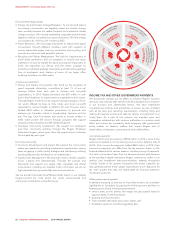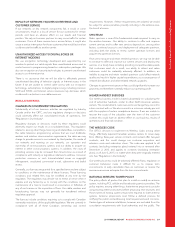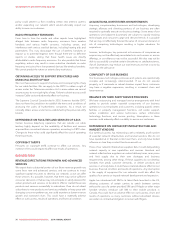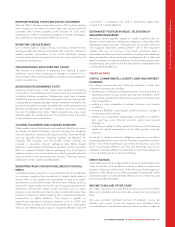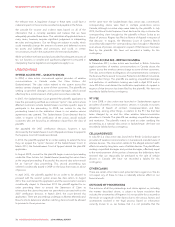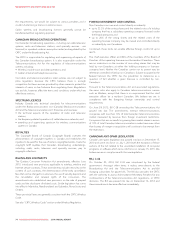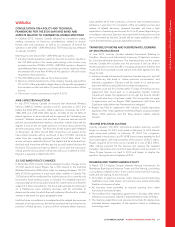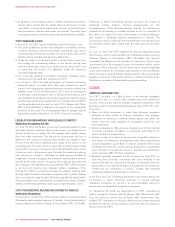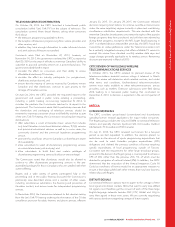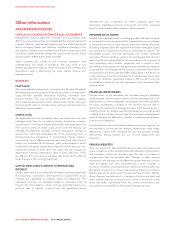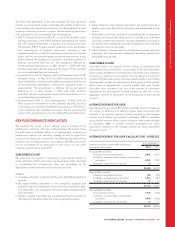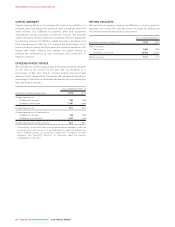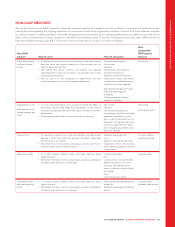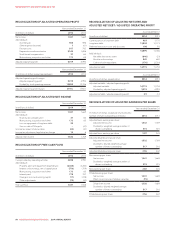Rogers 2014 Annual Report Download - page 80
Download and view the complete annual report
Please find page 80 of the 2014 Rogers annual report below. You can navigate through the pages in the report by either clicking on the pages listed below, or by using the keyword search tool below to find specific information within the annual report.MANAGEMENT’S DISCUSSION AND ANALYSIS
• In addition, a host network carrier is neither required to provide a
roamer with a service that the carrier does not provide to its own
subscribers, or to provide a roamer with a service, or level of service,
that the roamer’s network carrier does not provide. The policy does
not require seamless communications handover between networks.
CRTC WIRELESS CODE
In June 2013, the CRTC issued its Wireless Code. Key things to note:
• The code establishes several new obligations on wireless carriers,
including maximum contract term length, roaming bill caps, device
unlocking requirements and contract summaries. It also lays out the
rules for device subsidies and early cancellation fees.
• Under the code, if a customer cancels a contract early, carriers can
only charge the outstanding balance of the device subsidy they
received, which goes down by an equal amount every month over
no more than 24 months. This effectively makes the maximum
contract length two years.
• The code was applied to contracts (excluding enterprise plans)
entered into or renewed after December 2, 2013.
• As of June 3, 2015, the code will apply to all contracts (excluding
enterprise plans), no matter when they were entered into, which
means it will retroactively capture three-year contracts entered into
between June 3, 2012 and December 2, 2013. Anyone entering into
a three-year contract between June 3, 2012 and December 2, 2013
may therefore be entitled to cancel their agreement without paying
back the full subsidy they received. We do not believe that the CRTC
has the authority to do this, and on July 2, 2013, Rogers, Bell, Telus,
MTS and Sasktel filed a Federal Court appeal of this retroactivity
provision of the code. The Court granted leave to appeal and the
appeal was heard on November 12, 2014. A decision is pending.
LEGISLATION REGARDING WHOLESALE DOMESTIC
WIRELESS ROAMING RATES
On June 19, 2014, the federal government enacted legislation to cap
wholesale domestic wireless roaming rates carriers can charge to one
another at amounts no higher than the average rates carriers charge
their own retail customers. The formula the government will use to
determine the maximum roaming rates carriers can charge is their
revenue from the service divided by the usage of the service in the
preceding year. For voice calls, this means the incumbent carrier’s total
revenue for incoming and outgoing voice calls, divided by the number
of minutes used, in the previous year. For data, the maximum roaming
rate carriers can charge is calculated as data revenue divided by
megabytes. For text messaging, the maximum roaming rate is revenue
divided by the total number of ingoing and outgoing domestic-only
text messages. The legislation also provides the CRTC with the power
to set domestic roaming rates between carriers, regardless of the
formula. The CRTC is conducting a review into wireless roaming rates
and the state of wireless wholesale competition with a public hearing
which concluded in early October 2014 that may alter the rates further.
The proceeding is also reviewing the competitiveness of the Canadian
wireless market more generally. A decision is expected early in 2015.
CRTC PROCEEDING REGARDING DOMESTIC AND US
WIRELESS ROAMING
On December 12, 2013, the CRTC issued a call for comments entitled
Wholesale mobile wireless roaming in Canada – Unjust discrimination/
undue preference (Telecom Notice of Consultation CRTC 2013-685).
Following its earlier fact-finding exercise to assess the impact of
wholesale mobile wireless roaming arrangements on the
competitiveness of the Canadian wireless industry, the Commission
initiated this proceeding to consider whether or not, as a question of
fact, there is a situation of unjust discrimination or undue preference
with respect to wholesale roaming arrangements in Canada. The
Commission noted in particular that the wholesale roaming rates paid
by Canadian carriers were higher than the rates paid by American
carriers.
On July 31, 2014, the CRTC released its decision regarding unjust
discrimination and/or undue preference in wholesale wireless roaming
(Telecom Notice of Consultation CRTC 2013-685). The decision
concluded that Rogers (as the provider of roaming to almost every
new entrant) did in fact engage in unjust discrimination and/or undue
preference. The Commission did not determine a remedy regarding
unjust discrimination for wholesale roaming rates in the proceeding.
The Commission resolved that the implementation of the roaming rate
legislation described in the section above is a sufficient remedy until a
final decision is made in the wholesale service proceeding.
CABLE
VERTICAL INTEGRATION
The CRTC considers our Cable business to be vertically integrated
because we own or control both programming and distribution
services. It sets out the rules for vertically integrated companies in the
broadcast sector in its Broadcasting Regulatory Policy CRTC 2011-601.
The policy:
• Does not allow companies to make their television programs
exclusive to their mobile or Internet subscribers. Any program
broadcast on television, including hockey games and other live
events, must be made available to competitors under fair and
reasonable terms.
• Allows companies to offer exclusive programming to their Internet
or mobile customers provided it is produced specifically for an
Internet portal or a mobile device.
• Adopts a code of conduct to prevent anti-competitive behaviour
and ensure all distributors, broadcasters and online programming
services negotiate in good faith. To protect Canadians from losing
availability of a television service during negotiations, broadcasters
must continue to provide the service in question and distributors
must continue to offer it to their subscribers.
• Required vertically integrated entities to report by April 2012 on
how they have provided consumers with more flexibility in the
services that they can subscribe to through, for example, pick-and-
pay models. In our April 2012 report, we presented the results of a
market trial we conducted in London, Ontario that provided
additional programming flexibility to consumers.
In the 2014 Let’s Talk TV hearing described in the section below, the
Commission is again examining measures to ensure vertically
integrated companies do not act in an anti-competitive manner to
deny access to independent programming services.
On November 20, 2014, we responded to a CRTC complaint by
certain companies claiming that the Rogers NHL GameCentre LIVE
Plus, the exclusive content tier of Rogers NHL GameCentre LIVE,
violates CRTC regulations on the basis that it was not content designed
primarily for Internet use by individual customers. We are awaiting a
decision from the CRTC.
76 ROGERS COMMUNICATIONS INC. 2014 ANNUAL REPORT


